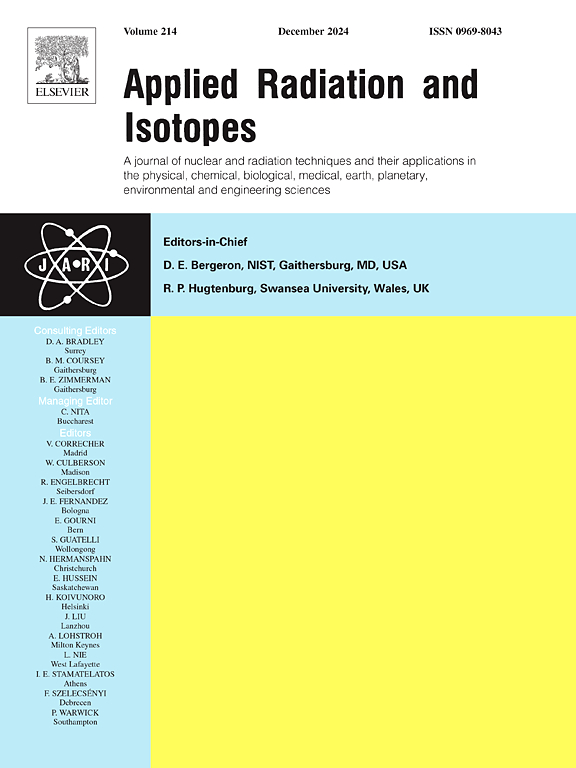Feasibility of new polymeric matrices in the production of ferrous sulphate dosimeters
IF 1.6
3区 工程技术
Q3 CHEMISTRY, INORGANIC & NUCLEAR
引用次数: 0
Abstract
External beam radiotherapy is a treatment modality that employs high doses for curative or palliative purposes. Safety in such treatments, particularly with high-precision equipment, necessitates strict adherence to quality control protocols to ensure the efficacy of oncological treatments. In this context, chemical dosimeters, particularly the Fricke gel, have emerged as valuable tools for quantitatively analysing absorbed radiation doses. These dosimeters can be applied both as tissue-equivalent phantoms and as radiation detectors in radiotherapy centers. The objective of this study was to evaluate the feasibility of new gelling matrices, comprising common materials such as CMC, GGU, and PVA, for producing ferrous sulphate dosimeters aimed at the relative quantification of radiation dose. A rheological study was conducted for different Fricke gel dosimetric formulations. Initially, the performance of these dosimeters, produced at various gel concentrations, was evaluated in terms of their consistency at room temperature. This was achieved through the straightforward process of humidification the gels with glycerine. These matrices consist of both natural and synthetic polymers that are readily accessible, easy to handle, and can be easily incorporated into the acidic ferrous sulphate solution. Parameters such as the influence of gelling matrix concentration, linearity, and stability were assessed and correlated with those previously investigated for Fricke gel produced with bloom 300 pig skin gelatine (GEL). Ferrous sulphate dosimeters fabricated with sodium carboxymethylcellulose (CMC), guar gum (GGU), and polyvinyl alcohol (PVA) exhibited a coefficient of variation of less than 1% relative to the dose response evaluated in this study. By using readily available and easily manageable materials, it is possible to replicate dosimeters with a favourable dosimetric response for high-dose measurements.
新型聚合物基质用于生产硫酸亚铁剂量计的可行性
体外放射治疗是一种采用高剂量以达到治疗或缓解目的的治疗方式。为确保此类治疗的安全性,尤其是高精度设备的安全性,必须严格遵守质量控制规程,以确保肿瘤治疗的有效性。在这种情况下,化学剂量计,尤其是弗里克凝胶,已成为定量分析吸收辐射剂量的重要工具。这些剂量计既可用作组织等效模型,也可用作放射治疗中心的辐射探测器。本研究的目的是评估由 CMC、GGU 和 PVA 等常见材料组成的新型胶凝基质用于生产硫酸亚铁剂量计的可行性,以便对辐射剂量进行相对量化。对不同的弗里克凝胶剂量计配方进行了流变学研究。首先,对这些以不同凝胶浓度生产的剂量计在室温下的一致性进行了性能评估。这是通过用甘油对凝胶进行直接加湿处理实现的。这些基质由天然和合成聚合物组成,容易获得,易于处理,并能轻松融入酸性硫酸亚铁溶液中。我们评估了胶凝基质浓度的影响、线性度和稳定性等参数,并将其与之前使用 Bloom 300 猪皮明胶(GEL)生产的弗里克凝胶的相关参数进行了比较。使用羧甲基纤维素钠(CMC)、瓜尔豆胶(GGU)和聚乙烯醇(PVA)制造的硫酸亚铁剂量计与本研究评估的剂量反应相比,变异系数小于 1%。通过使用现成且易于管理的材料,可以复制出具有良好剂量反应的剂量计,用于高剂量测定。
本文章由计算机程序翻译,如有差异,请以英文原文为准。
求助全文
约1分钟内获得全文
求助全文
来源期刊

Applied Radiation and Isotopes
工程技术-核科学技术
CiteScore
3.00
自引率
12.50%
发文量
406
审稿时长
13.5 months
期刊介绍:
Applied Radiation and Isotopes provides a high quality medium for the publication of substantial, original and scientific and technological papers on the development and peaceful application of nuclear, radiation and radionuclide techniques in chemistry, physics, biochemistry, biology, medicine, security, engineering and in the earth, planetary and environmental sciences, all including dosimetry. Nuclear techniques are defined in the broadest sense and both experimental and theoretical papers are welcome. They include the development and use of α- and β-particles, X-rays and γ-rays, neutrons and other nuclear particles and radiations from all sources, including radionuclides, synchrotron sources, cyclotrons and reactors and from the natural environment.
The journal aims to publish papers with significance to an international audience, containing substantial novelty and scientific impact. The Editors reserve the rights to reject, with or without external review, papers that do not meet these criteria.
Papers dealing with radiation processing, i.e., where radiation is used to bring about a biological, chemical or physical change in a material, should be directed to our sister journal Radiation Physics and Chemistry.
 求助内容:
求助内容: 应助结果提醒方式:
应助结果提醒方式:


